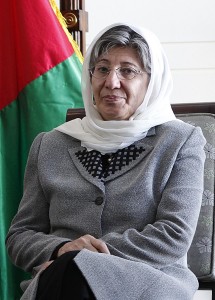
Sima Samar | Image courtesy Wikipedia
After traveling to an Afghan refugee camp in Quetta, Pakistan, in the mid-‘80s and witnessing the aid efforts of the Shuhada Organization’s founder, Dr. Sima Samar, Vreni Frauenfelder teamed up with four partners to form the Help Committee Schaffhausen (HCS) in 1988. A small nonprofit organization, HCS concentrates its activities on the construction and operation of health care facilities, schools, and orphanages in Afghan communities in need. HCS also supports Afghans living in vulnerable, isolated villages by delivering emergency food rations and facilitating the development of water supply infrastructure. Through its livestock distribution programs, HCS provides rural families with sheep and chickens that can be raised to produce agricultural goods that serve as a source of sustainable agricultural livelihoods that strengthen self-reliance in the local community.
Since its inception, HCS has partnered with the Shuhada Organization to coordinate the long-term operation of several projects in the central highlands of the Hazarajat region. HCS also collaborates with the Aryub Development and Welfare Group to carry out projects in Pashtun tribal areas in the south of Afghanistan. Seeking to help Afghans achieve self-sufficiency, HCS provides wages to local residents employed by its partner organizations and promotes the participation of beneficiaries in its aid initiatives by including community members in project design and implementation.
Contributions from individual and institutional donors fund the activities of HCS. Moreover, due to the fact that every HCS member serves on a voluntary basis, administrative costs remain low and the majority of donations directly support Afghans in need. The projects detailed here are a representative sample of the many diverse endeavors undertaken by HCS to assist the people of Afghanistan:
Building a Village for Displaced Bamiyan Residents
Due to the demolition of the Buddhas of Bamiyan in 2001, cave dwellings in the cliff face adjacent to the massive statues became uninhabitable, and many Hazara families who resided in these structures lost their homes. Together with the Shuhada Organization, HCS initiated a development project to build a village for the displaced people who had to resort to living in a tented refugee encampment without a direct water supply. The initial plans for the village, known as Kart-e Solh, included 80 houses and new drinking water wells. After construction was finished, families took ownership of the homes through a simple agreement to plant two trees in their yard and keep the community clean.
Continued Development of Kart-e Solh
In subsequent years, HCS has financed additional development and the ongoing operation of various public facilities in Kart-e Solh, including a school, health clinic, and an orphanage. Kart-e Solh High School features a library, chemistry lab, and nine classrooms where more than 1,500 students between the first and 10th grades receive instruction. The school also employs 41 teachers who work for HCS.
Situated immediately next door to the school, the orphanage in Kart-e Solh is home to approximately 65 children who have lost their parents due to war, illness, and other circumstances. Children over 7 years old attend the neighboring school, where they complete a standard academic curriculum, along with classes in English, cooking, theater, computer literacy, and other subjects. Until the children are able to take their university entrance exams and support themselves independently, they continue to live in the custody of the orphanage’s caretakers.
Located close to the center of Bamiyan, the Kart-e Solh Basic Health Center provides outpatient services for residents from three nearby villages and treats over 300 patients each month. The center, which includes a maternity ward, also delivers educational programming for men and women concerning family planning issues.
Supporting Rural Livelihoods Through Animal Distribution
Exemplifying HCS’ commitment to improving the welfare and livelihood of rural communities, a 2011 animal distribution project funded by the organization provided 40 sheep to 10 families in need in the Golistan village of Bamiyan. Each family received four sheep, along with reading, writing, and training courses on how to raise the animals for wool, meat, milk, and cheese production.
In order to extend the positive impact of distribution across the village, beneficiary families had to agree to gift one lamb from each newborn litter to another local family for the following three years. Recipient families also consented to providing 1 kilogram of wool to weave carpets that would be sold to raise funds for the purchase of school desks and chairs.
Bringing Health Services to Isolated Villages
Recognizing a critical need for medical services in the village of Mesh and the surrounding areas of Daykundi Province, HCS began operating a new health sub center in 2015. The small clinic is housed in a building donated by the local Mesh community and staffed by a trained nurse, midwife, and security and maintenance team, all employed by HCS. Until the center was established, residents of the remote region had no means of obtaining health care during the long, inclement winters, leading to a high incidence of fatalities from treatable, infectious diseases.
The presence of the center has contributed to a decline in the mortality rate among the roughly 3,000 residents of Mesh, as well as improved access to health care services for residents of nearby villages throughout the area. In addition to treating patients for many diseases largely resulting from poverty, the facility’s medical staff conducts outreach efforts to raise awareness among villagers about proper hygiene practices and other preventive health measures.

